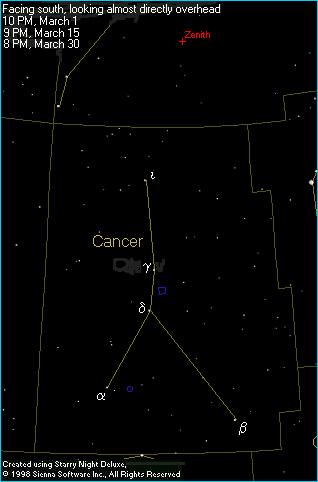


This is another star chart of Cancer to help you recognize the constellation in the sky, but this time I added some greek letters next to some of the brightest stars so that we can attach the names to what you're seeing in the sky. I always find that my appreciation for the sky is enhanced when I know the names and a little bit about what I'm looking at--it gives me a feeling of familiarity and as a result the sky has become like an old friend. As you may know, many but not all of the brightest stars in the sky have proper names (ie: Betelgeuse in Orion). Another method of naming stars involves the use of Greek letters and the genitive case of the Latin name, known as the "Bayer name". For example, the Bayer name for Acubens would be Alpha Cancri (pronounced KAN-kree). Anyway, this is a list of some of the major stars in Cancer with a brief description of each. Just match the star on the list to the greek letter in the picture!
Acubens [Alpha (a) Cancri]: The name of this star means the claws, and in classical representations of Cancer it does indeed represent the southern most claw of the crab. Shining at only magnitude +4.2, Acubens lies about 135 light-years away. As with most of Cancer's stars, you'll need a dark sky to see Acubens.
Acubens is actually a double star, but the companion is not visible in a small telescope. The companion shines at only 11th magnitude and lies about 11 seconds of arc away at position angle 322º. The dim magnitude of the companion alone makes it difficult to see in a small telescope, but couple that with the close proximity of much brighter Acubens and the companion is easily overwhelmed in the glare.
Altarf [Beta (b) Cancri]: The name Altarf comes from an Arabic phrase which means the end and is often depicted in classical drawings as representing the southernmost back leg of the crab. Altarf is the brightest of Cancer's stars, shining at only magnitude +3.6 from a distance of about 270 light-years. When you look at Altarf, you may notice a slightly orange color. That orange color means that Altarf is a relatively cool star with a surface temperature of only 3500ºC (6300ºF).
Beta is also a double star, but again the companion is not visible in a small telescope. The companion shines at only about 14th magnitude about 30 seconds of arc from the primary, making the star visible in only much larger amateur instruments.
Asellus Australis [Delta (d) Cancri]: Meaning the southern donkey, this star is part of an old asterism called the Donkeys and the Manger. The asterism is created by Asellus Australis and Asellus Boraelis as the donkeys, and the fuzzy star cluster M44 representing the manger. Located 130 light-years away, Delta is rather inconspicuous at magnitude +4.2.
Asellus Boraelis [Gamma (g) Cancri]: This star's name means the northern donkey, and is the second donkey in the Donkeys and Manger asterism. Located about 200 light-years away, this donkey shines slightly dimmer than the other at magnitude +4.7.
Iota (i) Cancri: Iota is an interesting double star easily visible in any small telescope. The system lies about 170 light-years away, and the primary star shines at magnitude +4.5. You can look for the magnitude +6.5 companion star about 30 seconds of arc away from the primary star at position angle 307º. The most eye-pleasing aspect of this double star is the nice color contrast between the two components. The primary has a soft yellow color while the companion appears slightly bluish.
The yellow primary star is a giant, about 10 times larger and 60 times more luminous than our own Sun. The blue companion is only slightly larger than the Sun, but it burns much hotter. The two stars are separated by a huge distance (about 150 billion miles!) and therefore orbit each other very slowly, taking about 30,000 years to complete one revolution around each other.
